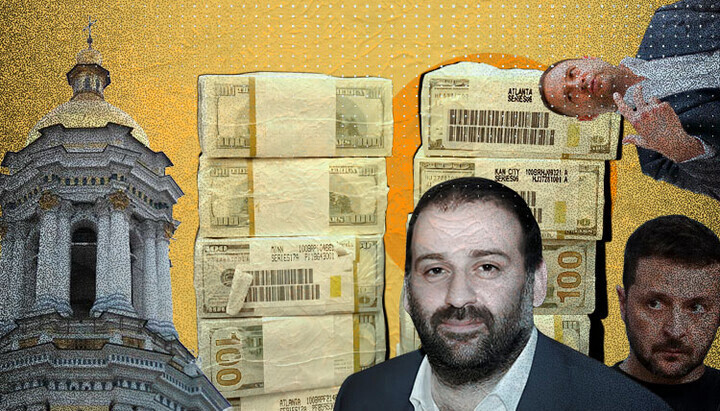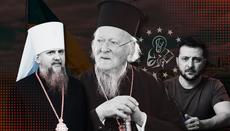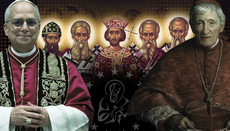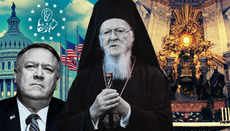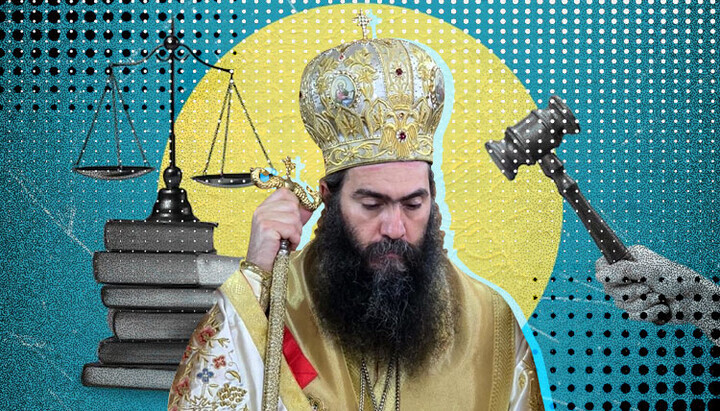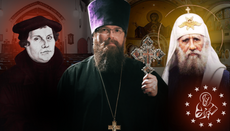Why the Uniates are Not the "Kyiv Church" and No One Should Believe Shevchuk
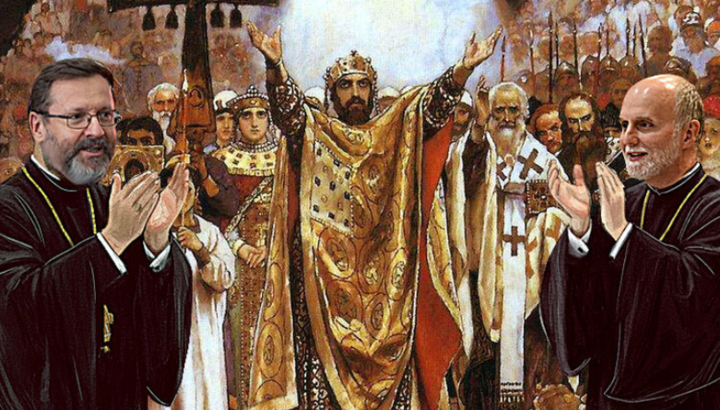
The head of the UGCC has moved from manipulation to the open dissemination of falsehoods. Here is a detailed analysis.
On August 17, 2025, the head of the Ukrainian “Greek Catholics,” Sviatoslav Shevchuk, met with young people in the Uniate cathedral of Kyiv. There he tried to persuade them that his Church was not born in 1596 at Brest, but rather in the baptismal waters of the Dnieper in 988.
What Orthodox historians and even Roman documents identify plainly as the Union of Brest was rebranded by Shevchuk as nothing more than “Moscow propaganda.” He further claimed that the Unia is “the only Ukrainian Church that unites the global Ukrainian community within itself.” And on the following day, August 18, at a round table, he went so far as to insist that the UGCC is not even part of the Roman Catholic Church.
This sudden burst of revisionism is no accident. It is carefully timed to coincide with the jubilee of the transfer of the Uniate primate’s residence from L’viv to Kyiv—or, as they themselves prefer to style it, not a transfer at all, but a “return.” Yet behind the fanfare lies only a web of calculated distortions.
The Jesuit Moral-Ethical System
Before proceeding to a historically grounded refutation of these Uniate narratives, it is necessary to indicate why the Uniate primate broadcasts such blatant falsehoods to his audience.
Whether or not Shevchuk himself is a Jesuit in any formal sense, we do not know, but the ideology of that order has had enormous influence on the worldview of many Catholics and has shaped the modus operandi of Catholic leaders—Shevchuk included.
The Jesuit motto, coined in the 16th century by their founder Ignatius of Loyola, reads: Ad maiorem Dei gloriam inque hominum salutem (“For the greater glory of God and the salvation of mankind”). According to their interpretation, if achieving this goal requires an immoral act or breaking a divine commandment, it is permissible and justified. Scholars of the order highlight three key principles in the Jesuit moral system:
- Intentionality: A deed is sinful only if consciously directed toward a sinful end. If done “for the greater glory of God” (Ad maiorem Dei gloriam), the sin is excusable or forgivable.
- Mental reservation: One may give words a meaning entirely different—even opposite—from their surface meaning, and such statements will not count as lies. Any false assertion is not considered falsehood if inwardly (mentally) one adds “perhaps” or something similar.
- Probabilism: Doubtful issues are resolved not on moral grounds but based on whether they serve the desired goal.
That Shevchuk distorts truth, gives absurd interpretations of historical facts, or outright lies fits perfectly into this Jesuit framework, which—let us emphasize—deeply permeates Catholic consciousness.
We stress this for two reasons. First, to show that these deceptive narratives are not Shevchuk’s personal style, but a hallmark of much of Catholicism itself. For Uniates especially, this is typical: for over 400 years they have been forced to prove to Catholic audiences that they are indeed Catholics, while simultaneously trying to appear Orthodox to Orthodox audiences. Second, to encourage Orthodox hierarchs to view some of their own words and actions critically: do they not also fit into the same Jesuit pattern?
Falsehood #1: The UGCC Is Not Part of the Roman Catholic Church
Shevchuk does not govern independently but only as a delegate of papal power exercised over each UGCC diocese. His rhetoric about “building our own” contradicts the very structure of Catholic ecclesiology. That is why the UGCC is still denied patriarchal status—something granted to other Uniate Churches like the Maronite, Chaldean, and Melkite.
Exact quote from Shevchuk, August 18, 2025:
“We (the UGCC) are a local Church in communion with the Roman Pope, but we do not belong to the Western Patriarchate. We are building our own.”
From these words, it seems as though the UGCC is linked to Rome only through Eucharistic communion, but not subject to its administrative authority. It could even appear that the UGCC and the “Western Patriarchate” are on some level equal local Churches. But in reality, the UGCC is an administrative part of the Catholic Church and subjected to it — not merely in communion with it.
In Catholicism, unlike Orthodoxy, there are no independent local Churches equal in canonical standing. To be Catholic necessarily means to be under the full authority of the Roman Pope and his curia.
The Catechism of the Catholic Church states:
“The Roman Pontiff, by reason of his office as Vicar of Christ and pastor of the whole Church, has full, supreme, and universal power over the whole Church, a power which he can always freely exercise.”
Canon 331 of the Code of Canon Law repeats this explicitly. Canon 333 further stresses papal authority over all Catholic structures, including the Eastern-rite Churches like the UGCC.
Thus, Shevchuk does not govern independently but only as a delegate of papal power exercised over each UGCC diocese. His rhetoric about “building our own” contradicts the very structure of Catholic ecclesiology. That is why the UGCC is still denied patriarchal status—something granted to other Uniate Churches like the Maronite, Chaldean, and Melkite.
Falsehood #2: The UGCC Was Born in the Waters of the Dnieper in 988
Exact quote from Shevchuk, August 17, 2025:
“So many centuries Moscow propaganda told us we were never in Kyiv. They said we appeared only in 1596 at the Union of Brest. But that is false. We were born a thousand years ago here in Kyiv, in the waters of the Dnieper at the Baptism of Saint Prince Volodymyr.”
Here one falsehood builds on another. Shevchuk argues that since in 988 Rome and Constantinople were not yet formally divided (the schism of 1054 lay ahead), the Kyivan Metropolis was therefore in communion with Rome, making the UGCC its successor.
But already in the 10th century, the Latin and Greek Churches were seen as distinct. Both Princess Olga and Prince Vladimir rejected Latin envoys as rivals of Constantinople. The dogmas dividing Orthodoxy and Catholicism—like the Filioque and papal supremacy—were already entrenched in the West before 988. Thus, those baptized in the Dnieper became Orthodox, not Catholics.
The actual origins of the UGCC lie in the Union of Brest (1596), when bishops formally renounced Orthodoxy and submitted to Rome—largely the result of more than two hundred years of brutal repression by the Latin kings of Poland. Documents from 1595–1596, papal bulls, and episcopal oaths prove this beyond question.
Therefore, the UGCC cannot claim succession from the Kyivan Metropolis of 988. Its true lineage is that of the Ruthenian Uniate Church (Ecclesia Ruthena unita), born in 1596.
Falsehood #3: The Uniate Church “Unites All Ukrainians”
Quote from Shevchuk, August 17, 2025:
“Today many more Ukrainians seek the voice of our Church than those who call themselves Greek Catholics. We are the only Ukrainian Church that unites the global Ukrainian community.”
And on August 15, 2025, with the new ambassador to Sweden, Shevchuk repeated:
“The UGCC is the only Ukrainian Church that unites the global Ukrainian community.”
But statistics tell another story. Within Ukraine, sociological surveys place UGCC affiliation at 8–10% of the population. According to government data, as of January 1, 2024, of 36,195 religious communities, 29% belonged to the UOC, 22% to the OCU, and only 10% to the UGCC. Clearly, it cannot claim to unite the “worldwide Ukrainian community.”
Why Shevchuk Pushes These Narratives
Aside from the Jesuit style noted above, Shevchuk likely anticipates the eventual merging of the Orthodox Church of Ukraine and Uniates into a single “Kyiv Church.” In interviews, he presents the UGCC as the natural center of such a union, hence the insistence on its antiquity, its alleged baptismal roots in 988, and its role as unifier of Ukrainians.
It all sounds appealing—but it is false. False from beginning to end.
Postscript
As the Roman statesman Cato the Elder ended each speech with “Carthage must be destroyed” (Carthago delenda est), so every article about the Uniates ought to end with Taras Shevchenko’s poem To the Poles. It is a sobering antidote after hearing Shevchuk’s sweet words:
When we were still Cossacks,
And no one yet had heard of the Union,
Then life was joyful indeed!
… Until, in the name of Christ,
The priests came and set aflame
Our quiet paradise, spilling wide
A sea of tears and blood.
… O Pole, friend, brother mine!
Greedy priests and magnates
Divided us and drove us apart—
But we could have lived as one.
Give your hand, O Cossack,
Give your pure heart!
And again, in Christ’s name,
We shall renew our quiet paradise.
May the Lord remember all those faithful Orthodox Christians who were persecuted, tortured, burned alive in their churches with their families for refusing to submit to the False Union of Brest — these were the building blocks of Shevchuk's "church."
